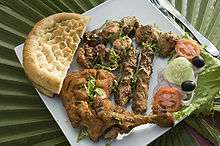Pasanda
|
Pasanda Curry | |
| Course | Main course |
|---|---|
| Place of origin | Mughal India |
| Region or state | Indian Subcontinent |
| Associated national cuisine | India, Bangladesh, Pakistan |
| Main ingredients | Meat (Lamb, Goat or Beef), (Poultry or Seafood) |
| Variations | Poultry or Prawns |
Pasanda (Urdu: پسندہ) is a popular meat dish from the Indian subcontinent, notably North Indian, Hyderabadi and Pakistani, derived from a meal served in the court of the Mughal emperors. The word is a variation on the Urdu word "pasande" meaning "favourite", which refers to the prime cut of meat traditionally used within.
Ingredients and preparation
Pasanda was originally made with leg of lamb or Goat flattened into strips, marinated, and fried in a dish with seasoning. In Pakistan, the Pasanadays are usually made from Pot Roast Beef Fillets flattened into strips.[1] In the present day, pasanda is also made using chicken and king prawns; in each case, the process and ingredients remain generally the same.
After the meat is cut and flattened, it is placed in a marinade consisting of yogurt, chili powder, and numerous spices and seasonings, which commonly include cumin, peppercorn, cardamom, and garlic. After a few hours of marination, the meat is placed in a saucepan with the other ingredients that make up the "pasanda" itself—onions, coriander, chillies, and sometimes cinnamon or black pepper—then fried for 30 minutes to an hour. The dish may be garnished with tomatoes or almonds (in which case it is known as badaam pasanda). It is often served with white rice or naan bread on the side.
Variants: Kebabs
Although pasanda is usually served as a meat dish, it may also be prepared in kebab form. Reflecting the dish's flavour and its connection with the almond, pasanda also refers to a mild curry sauce made with cream, coconut milk or yoghurt and almonds.
See also
- List of lamb dishes
- Pakistani meat dishes






